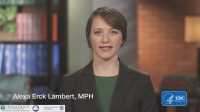
23 Apr Soft Bedding such as Blankets and Pillows Can Suffocate Babies
MedicalResearch.com Interview with:
Alexa B. Erck Lambert, MPH
DB Consulting Group, Inc, Silver Spring, Maryland
Centers for Disease Control and Prevention Contractor
MedicalResearch.com: What is the background for this study? What are the main findings?
Response: Unintentional suffocation is the leading cause of injury death among infants under 1 year old in the US. This study investigates cases in CDC’s SUID Case Registry that were assigned the category of explained suffocation with unsafe sleep factors per CDC’s SUID Case Registry classification system, which was developed to consistently differentiate SUID cases into well-defined categories (including no autopsy or death scene investigation, incomplete case information, no unsafe sleep factors, unsafe sleep factors, possible suffocation with unsafe sleep factors, and explained suffocation with unsafe sleep factors) using standardized criteria and definitions. Cases classified as possible and explained suffocation were assigned one more mechanisms to which the airway obstruction was attributed including soft bedding, wedging, overlay and other – other was excluded from this analysis.
Most explained suffocations (69%) were attributed to soft bedding like a blanket or a pillow followed by overlay (19%), and wedging (12%). Although explained suffocation deaths represent a small proportion of all sudden unexpected infant deaths (14%), these losses are particularly tragic because they can be prevented by placing a baby to sleep in a safe environment.
MedicalResearch.com: What should readers take away from your report?
Response: Although explained suffocation deaths represent a small proportion of all sudden unexpected infant deaths (14%), these losses are particularly tragic because they can be prevented by placing a baby to sleep in a safe environment.
These findings provide an important reminder of the value of the safe sleep practices recommended by the AAP, which include:
- Placing the baby on his or her back for every sleep – including naps and at night.
- Using a firm sleep surface, such as a mattress in a safety-approved crib.
- Keeping soft objects and loose bedding out of the baby’s sleep area.
- Sharing a room with baby, but not the same bed.
MedicalResearch.com: What recommendations do you have for future research as a result of this work?
Response: There are a couple of opportunities for future research to build on this study’s safe sleep-related findings, including:
- Studies to help quantify the risk associated with various unsafe sleep practices; and
- Studies with a diverse group of caregivers to help understand different sociocultural contexts for and barriers to following recommended safe sleep practices.
MedicalResearch.com: Is there anything else you would like to add?
Response: Again, I think our findings give us an important opportunity to revisit the safe sleep practices recommended by the AAP, which include:
- Placing the baby on his or her back for every sleep – including naps and at night.
- Using a firm sleep surface, such as a mattress in a safety-approved crib.
- Keeping soft objects and loose bedding out of the baby’s sleep area.
- Sharing a room with baby, but not the same bed.
For this research, I was supported by a contract between DB Consulting Group and the Division of Reproductive Health, National Center for Chronic Disease Prevention and Health Promotion, Centers for Disease Control and Prevention (prime contract: hhsn316201200076w; task order number: 200-2017-f-94805).
Citation:
“Sleep-Related Infant Suffocation Deaths Attributable to Soft Bedding, Overlay, and Wedging,” (Erck Lambert, AB, et al. Pediatrics.April 22, 2019, https://doi.org/10.1542/peds.2018-3408).
[wysija_form id=”3″]
[last-modified]
The information on MedicalResearch.com is provided for educational purposes only, and is in no way intended to diagnose, cure, or treat any medical or other condition. Always seek the advice of your physician or other qualified health and ask your doctor any questions you may have regarding a medical condition. In addition to all other limitations and disclaimers in this agreement, service provider and its third party providers disclaim any liability or loss in connection with the content provided on this website.
Last Updated on April 23, 2019 by Marie Benz MD FAAD

